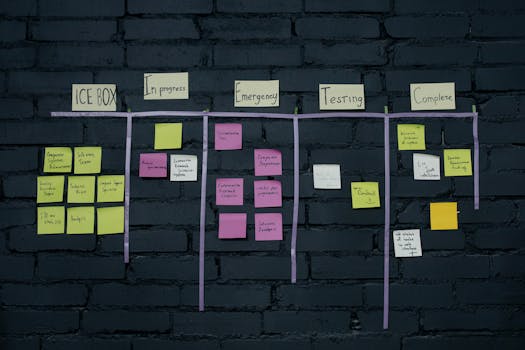Implementing Best Practices in Project Management
In today's fast-paced business environment, effective project management is more critical than ever. Implementing best practices in project management not only helps teams deliver projects on time and within budget, but also improves overall efficiency and stakeholder satisfaction. With the right methodologies and frameworks in place, project managers can navigate through challenges smoothly and achieve impressive results. 🚀
This article will delve into the theoretical foundations of project management best practices and provide practical examples for real-life applications. By adopting these strategies, you can transform your project delivery process and foster a culture of success within your organization. Let’s get started! 🔍

📊 Key Concepts
Understanding the theory behind implementing best practices in project management is vital for success. Here are some key concepts you'll need to grasp:
📈 1. Project Management Frameworks
Project management frameworks provide structured guidelines for handling projects efficiently. Notable frameworks include:
- PMBOK (Project Management Body of Knowledge): A comprehensive guide that includes various processes, knowledge areas, and best practices.
- Agile Methodology: A flexible approach that promotes iterative development and collaboration among team members.
Choosing the right framework depends on the project type, team dynamics, and organizational culture. 🗂️
🔄 2. Stakeholder Engagement
Engaging stakeholders throughout the project's lifecycle is crucial. Effective communication and collaboration reduce misunderstandings and foster a shared vision. Here are a few techniques for effective stakeholder engagement:
- Regular Updates: Keep stakeholders informed of project progress through emails, meetings, or dashboards.
- Feedback Loops: Encourage stakeholders to provide input, which can shape project direction and drive buy-in. 🤝
💡 3. Risk Management
Identifying and managing risks is a cornerstone of project management. A proactive approach involves:
- Risk Analysis: Analyze possible risks and their impact on the project.
- Mitigation Strategies: Develop plans to minimize the likelihood and impact of identified risks. 📉
🗓️ 4. Change Management
Projects often undergo changes, whether caused by new requirements or unforeseen issues. Implementing a change management strategy ensures that changes are handled effectively. Key steps include:
- Change Control Process: Establish a clear process for requesting and approving changes.
- Documentation: Keep detailed records of changes and their impacts on project scope, timelines, and costs.
With a solid understanding of these concepts, let's explore how to apply them in practical scenarios.
🎯 How to Apply
Applying best practices in project management isn't just theoretical; it requires action. Here are some practical examples to guide you:
📋 Step 1: Define Project Goals & Objectives
Goal Setting: Clearly define the goals and objectives of the project at the outset. Use the SMART criteria (Specific, Measurable, Achievable, Relevant, Time-bound) to create well-defined objectives.
📌 Example: Instead of stating "improve customer service," you could say "reduce customer response time by 25% within six months."
📊 Step 2: Develop a Project Plan
Once the goals are set, develop a comprehensive project plan that outlines:
- Scope: Define what is included and what is not.
- Timeline: Break down the project into phases with deadlines.
- Resources: Identify the necessary resources and assign roles.
📈 Example: Use Gantt charts to visualize timelines and task dependencies. This can help track progress and avoid bottlenecks.
🔍 Step 3: Create a Communication Plan
Establish a communication strategy early on to facilitate ongoing dialogue. Your plan should include:
- Stakeholder Identification: Who needs to be kept in the loop?
- Communication Channels: Define how updates will be delivered (emails, meetings, etc.).
- Frequency: How often will communication occur?
📞 Example: Schedule bi-weekly meetings to provide status updates, and use chat tools for daily communication.
📅 Step 4: Implement Risk Management
Integrate risk management strategies into your planning phase:
📉 Step 4.1: Conduct a Risk Assessment to identify potential risks.
📌 Example: Create a Risk Register to document identified risks, their likelihood, and impact.
📉 Step 4.2: Develop Mitigation Plans for each risk.
📌 Example: If a key team member might leave, have a plan to transfer knowledge and responsibilities.
🛠️ Step 5: Monitor Progress and Adapt
Regularly monitor project progress against the plan. If deviations occur, adapt:
🔄 Example: Conduct monthly reviews to evaluate progress, using KPIs to measure success. If a project falls behind, reassess resource allocation or timeline.
📝 Step 6: Conduct a Post-Project Review
After project completion, hold a post-mortem meeting to analyze:
- What worked well?
- What didn't work?
- Lessons learned for future projects.
🗂️ Example: Document lessons learned in a central repository to reference for future projects.
Manage projects with Workfeed
Workfeed is the project management platform that helps small teams move faster and make more progress than they ever thought possible.
Get Started - It's FREE* No credit card required
🛠️ Frequently Asked Questions
Here are some frequently asked questions about "Implementing Best Practices in Project Management".
🎉 Conclusion
Successfully implementing best practices in project management requires a blend of solid understanding, consistent application, and adaptability. By defining clear goals, creating comprehensive plans, engaging stakeholders, managing risks, and reflecting on experiences, project managers can enhance their effectiveness and ensure the success of their projects.
Take these strategies to heart, keep experimenting, and watch your project management skills elevate! 🌟 With enthusiasm and the right practices, you’re on your way to leading successful projects that resonate with stakeholders and deliver results.